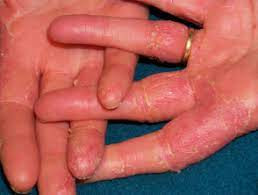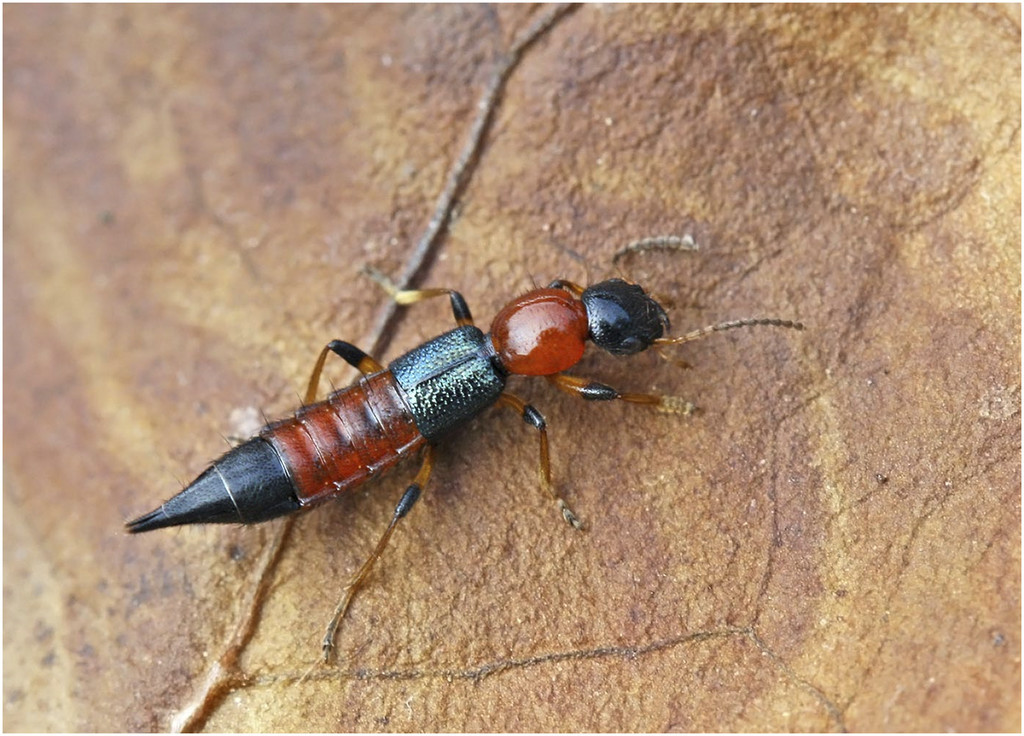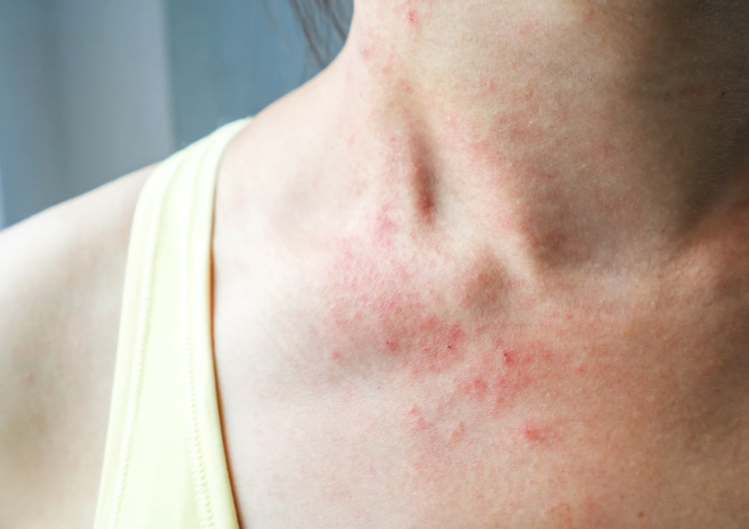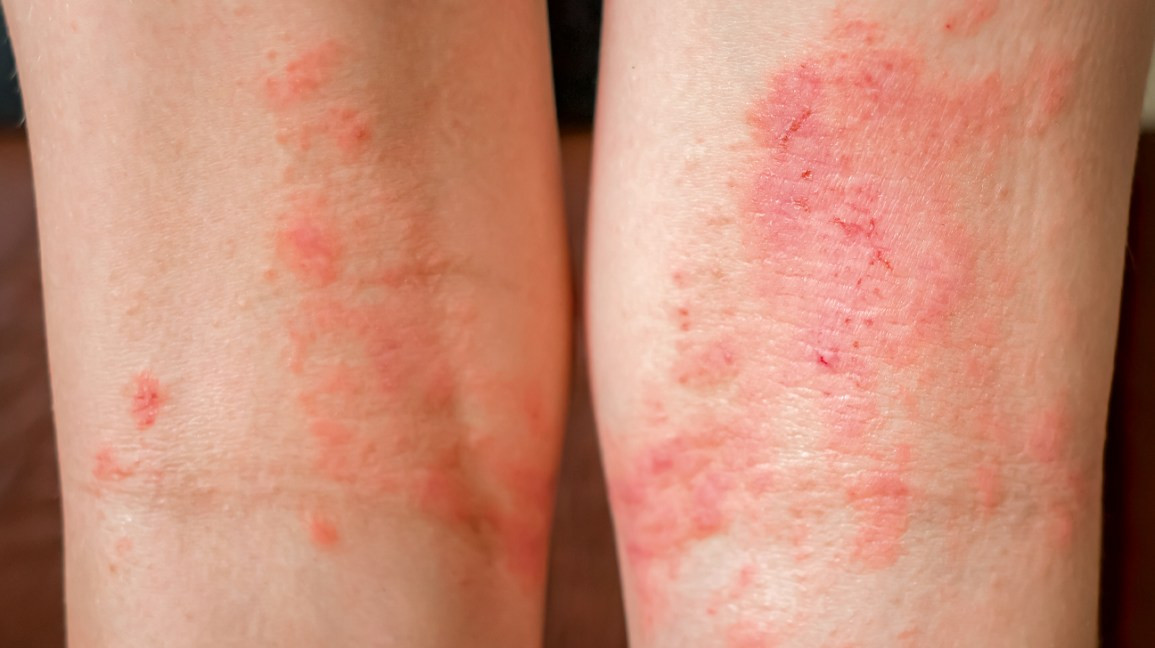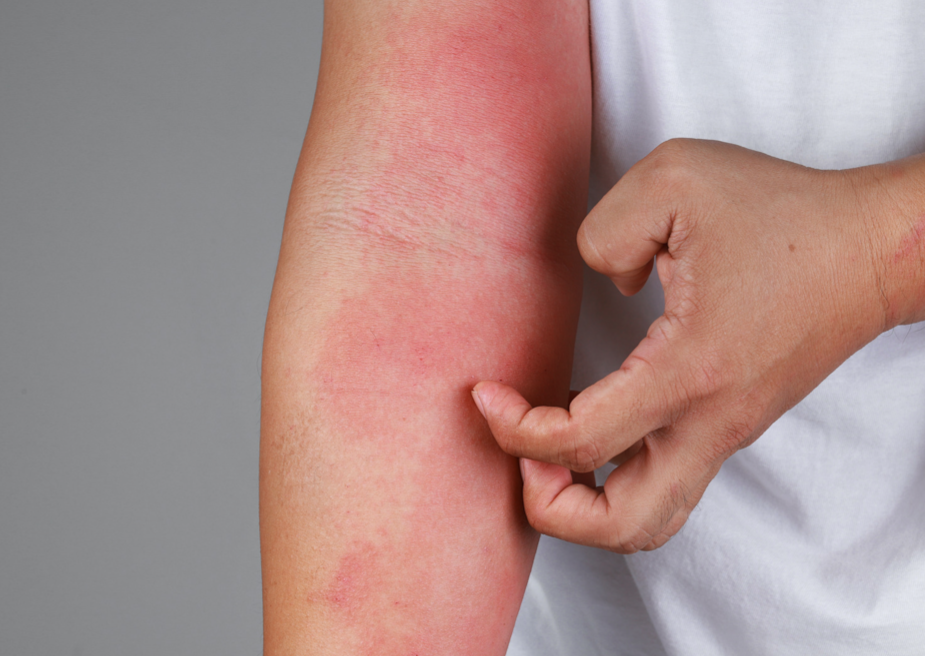Definisi
Dermatitis kontak iritan (DKI) adalah peradangan kulit akibat paparan langsung bahan kimia yang mengiritasi kulit. Setelah terpapar bahan iritan atau pemicu iritasi, sel kulit akan melepaskan zat-zat peradangan sehingga timbul gejala.
DKI bukan merupakan reaksi alergi dan bisa bersifat akut (jangka pendek) atau kronis (jangka panjang). Zat iritan umum antara lain deterjen, sabun, pembersih, dan zat asam.
Penyebab
Hampir semua bahan dapat mengiritasi kulit jika paparannya cukup lama atau sering dan kandungan bahan iritannya cukup tinggi. Faktor lingkungan dapat meningkatkan efek dari beberapa iritan.
Udara kering dan perubahan suhu
Udara kering membuat kulit lebih rentan terhadap iritasi kulit. Sebagian besar kasus gatal pada musim dingin adalah akibat dari udara musim dingin yang cenderung kering. Peningkatan suhu juga dapat meningkatkan efek iritasi kulit.
Air
Terkena air secara terus-menerus dapat menyebabkan maserasi atau penguapan air yang berulang dari kulit dan menyebabkan iritasi akibat pengeringan kulit.
Pelarut
Banyak pasien yang mengalami DKI akibat terpapar pelarut, terutama di tempat kerja. Pelarut seperti alkohol atau xilena menghilangkan lapisan lemak kulit sehingga memicu dermatitis kontak iritan langsung dan membuat kulit lebih rentan terhadap iritasi lainnya, seperti sabun dan air. Dermatitis kontak iritan dari alkohol sebagian besar bersifat kumulatif atau efeknya bertambah seiring durasi dan seringnya terpapar.
Pembersihan kulit yang tidak tepat adalah penyebab utama dermatitis kontak iritan di tempat kerja. Pekerja yang menggunakan tangan umumnya tidak mencuci tangan dengan tepat, yaitu menggunakan pelarut untuk menghilangkan minyak, lemak, cat, atau bahan lainnya. Sehingga, sering mengalami dermatitis kontak iritan.
Yang termasuk bahan iritan antara lain pelarut aromatik, alifatik, dan pelarut terklorinasi seperti pelarut terpentin, alkohol, ester, dan keton. Beberapa pelarut organik menghasilkan reaksi kemerahan langsung pada kulit dan menghilangkan lemak dari lapisan atas kulit.
Cairan pada pengerjaan logam
Minyak pelumas neat oil paling sering menyebabkan jerawat dan folikulitis atau infeksi kantung rambut. Minyak tersebut juga dapat menyebabkan dermatitis kontak iritan. Cairan pengerjaan logam berbasis air sering menyebabkan dermatitis kontak iritan karena mengandung zat surfaktan.
Dermatitis kontak iritan kumulatif
DKI ini terjadi karena paparan yang terus-menerus terhadap iritan. Hal ini biasa terjadi pada pekerjaan yang mengharuskan petugas sering bersentuhan dengan bahan kimia. Contohnya seperti petugas kesehatan yang harus mencuci tangan 20-40 kali sehari. Paparan serupa juga terjadi pada orang yang mencuci rambut berulang kali serta pada pembersih atau pekerja dapur.
Trauma mekanik
Tekanan menimbulkan pembentukan kalus atau mata ikan. Benturan dapat menghasilkan petechiae dan ekimosis, yaitu pendarahan di bawah kulit atau memar. Trauma atau gesekan yang tiba-tiba menimbulkan lepuh pada kulit. Menggosok atau menggaruk berulang akan membuat kulit menjadi keras dan kasar. Keringat dan gesekan tampaknya menjadi penyebab utama dermatitis pada anak yang menggunakan pelindung tulang kering saat bermain bola.
Sarung tangan karet
Beberapa sarung tangan karet dapat memicu iritasi kulit secara langsung. Banyak pekerja yang mengeluhkan iritasi akibat bedak pada sarung tangan karet. Sarung tangan yang berlubang memungkinkan paparan bahan iritan ke kulit sehingga meningkatkan risiko iritasi. Kondisi kulit yang tertutup sarung tangan meningkatkan efek iritasi. Minyak tanah dan etilen oksida pada bahan medis untuk pembedahan juga dapat menimbulkan perubahan kulit serupa, terutama pada kulit yang tertutup.
Sodium lauryl sulfate
Bahan kimia ini ditemukan pada beberapa obat luar, terutama obat jerawat, serta berbagai sabun dan sampo.
Asam fluorida
Luka bakar akibat asam fluorida adalah kondisi darurat medis. Gejala mungkin timbul terlambat setelah paparan akut (ini sangat penting untuk diagnosis). Sayangnya, luka bakar asam fluorida paling sering terjadi pada jari, di mana rasa sakitnya paling parah dan penanganannya paling sulit.
Alkali atau zat basa
Permukaan kulit biasanya memiliki pH asam. Kondisi alkali, misalnya, jika terkena banyak sabun, dapat menimbulkan lebih banyak iritasi dibandingkan pada kondisi asam. "Mantel asam" pada lapisan atas kulit berguna sebagai pelindung dan pertahanan terhadap kuman. Penggunaan bahan pembersih kulit, terutama deterjen sintetis dengan pH sekitar 5,5, dapat membantu mencegah penyakit kulit.
Faktor Risiko
Beberapa pekerjaan dan hobi dapat membuat Anda lebih berisiko terkena dermatitis kontak iritan, seperti petugas kesehatan, pekerja logam, pekerja konstruksi, penata rambut dan ahli kecantikan, mekanik mobil, atau pekerja pertanian.
Gejala
Dermatitis kontak biasanya terjadi pada area tubuh yang langsung terpapar zat iritan. Ruam biasanya muncul dalam beberapa menit hingga jam setelah terpapar dan dapat berlangsung selama 2-4 minggu minggu. Tanda dan gejala dermatitis kontak meliputi:
- Ruam merah
- Gatal, yang bisa menjadi parah
- Kulit kering, pecah-pecah, bersisik
- Benjolan
- Lecet, terkadang dengan keluarnya cairan dan pengerasan kulit
- Pembengkakan
- Rasa terbakar atau seperti tersengat
- Nyeri tekan
Beberapa saat setelah terpapar atau pada kondisi akut, akan timbul kemerahan, bengkak ringan, dan kulit tampak bersisik. Sementara, pada DKI yang kronis ditandai dengan likenifikasi atau kulit menebal, keras, dan kasar. Juga dapat tampak retakan-retakan kecil pada kulit hingga timbul borok.
Tangan adalah lokasi yang paling sering mengalami dermatitis kontak iritan. Dermatitis kontak iritan akibat paparan berulang terhadap sabun, pembersih, dan pelarut adalah penyebab dari sebagian besar gangguan kulit akibat kerja.
Diagnosis
Tidak ada tes diagnostik yang dapat diandalkan pada dermatitis kontak iritan. Diagnosis ditegakkan melalui wawancara gejala, riwayat kesehatan dan paparan zat iritan, serta pemeriksaan kulit.
Dokter dapat merekomendasikan uji tempel pada kasus yang parah atau menetap, yang penyebab ruamnya belum jelas, atau untuk menyingkirkan dermatitis kontak alergi.
Tata Laksana
Pengobatan pasti untuk dermatitis kontak iritan adalah mengetahui bahan iritan penyebab dan menghindari atau menghilangkan pajanannya. Berikut beberapa pilihan pengobatan.
Perubahan gaya hidup dan pengobatan rumahan
Untuk membantu mengurangi gatal dan menenangkan kulit yang meradang, cobalah penanganan sederhana berikut:
- Hindari zat iritan. Kuncinya adalah mengetahui zat iritan apa yang menimbulkan gejala pada kulit
- Oleskan krim atau lotion anti gatal. Krim tanpa resep yang mengandung 1% hidrokortison dapat meredakan gatal untuk sementara. Salep steroid dapat dioleskan satu atau dua kali sehari selama 2-4 minggu. Atau bisa juga mencoba losion kalamin
- Minum obat anti gatal. Golongan kortikosteroid dan antihistamin oral (diminum) yang dijual bebas dapat membantu jika gatal bertambah parah
- Kompres dingin. Basahi waslap lembut dan letakan pada kulit yang meradang untuk menenangkan kulit selama 15-30 menit. Ulangi beberapa kali sehari
- Hindari menggaruk. Potong kuku Anda. Jika Anda tidak dapat menahan untuk tidak menggaruk, tutup area yang gatal dengan kassa atau pelindung
- Lindungi tangan Anda. Bilas dan keringkan tangan dengan baik dan lembut setelah dicuci. Gunakan pelembab sepanjang hari dan pilih sarung tangan yang tidak mengandung bahan iritan
- Orang dengan kulit rentan, misalnya, pada dermatitis atopik atau rosacea wajah, sebaiknya menggunakan pembersih, kosmetik, pelembab, atau pelindung yang bersifat iritan ringan
Jika penanganan di rumah tidak meredakan tanda dan gejala, dokter dapat meresepkan obat, seperti:
- Krim atau salep steroid yang lebih kuat, membantu menenangkan ruam dermatitis kontak. Steroid topikal (obat luar) dapat dioleskan satu atau dua kali sehari selama 2-4 minggu
- Obat-obatan oral. Pada kasus yang parah, dokter akan meresepkan kortikosteroid oral untuk mengurangi peradangan, antihistamin untuk meredakan gatal, atau antibiotik untuk melawan infeksi bakteri
Komplikasi
Kulit yang meradang dapat menjadi tempat pertumbuhan kuman, termasuk bakteri Staphylococcus aureus. Komplikasi ini terjadi terutama jika Anda berulang kali menggaruk area yang terkena dan menjadi basah serta mengeluarkan cairan. Kondisi ini menciptakan tempat yang baik bagi bakteri atau jamur untuk tumbuh dan dapat menyebabkan infeksi.
Neurodermatitis sekunder atau liken simpleks kronis dapat muncul pada pasien dermatitis kontak iritan, terutama yang terpapar di tempat kerja atau di bawah tekanan psikologis. Neurodermatitis merupakan peradangan kulit jangka panjang dan kambuh-kambuhan.
Hiperpigmentasi (bercak gelap) atau hipopigmentasi (bercak yang lebih terang dari warna kulit) pasca peradangan dapat terjadi pada area yang terkena atau menetap setelah DKI sembuh pada orang dengan kulit yang lebih berpigmen.
Jaringan parut dapat timbul karena paparan zat korosif, kerusakan kulit, atau luka pada kulit. Dermatitis kontak iritan meningkatkan risiko sensitisasi terhadap obat topikal.
Pencegahan
Langkah-langkah pencegahan dermatitis kontak secara umum adalah:
- Hindari bahan iritan. Cobalah untuk mencari tahu zat iritan apa yang memicu DKI Anda dan menghindari zat tersebut
- Cuci kulit segera setelah bersentuhan dengan zat iritan. Gunakan sabun yang lembut, bebas pewangi, pewarna, dan gunakan air hangat. Lalu bilas hingga bersih. Cuci juga pakaian atau barang lain yang mungkin terkena zat iritan
- Kenakan pakaian pelindung atau sarung tangan. Masker wajah, kacamata, sarung tangan, dan barang pelindung lainnya dapat melindungi Anda dari zat yang mengiritasi, termasuk pembersih rumah tangga
- Gunakan pelembab. Mengoleskan lotion pelembab secara teratur dapat membantu memulihkan lapisan terluar kulit, menjaga kulit tetap lembut, dan mengurangi peradangan
Kapan Harus ke Dokter?
Konsultasi ke dokter jika:
- Ruam menjadi melepuh
- Ruam dan gejala kulit lainnya kambuh
- Gatal terus-menerus
- Ruam sangat tidak nyaman sehingga Anda kurang tidur atau mengganggu aktivitas sehari-hari
- Ruam tiba-tiba terasa nyeri, parah, atau meluas
- Ruam tidak hilang dalam seminggu dengan pengobatan
- Ruam mempengaruhi wajah atau alat kelamin
Cari perawatan medis segera dalam situasi berikut:
- Anda curiga terdapat infeksi pada kulit, ditunjukan dengan adanya demam, kemerahan, bengkak, teraba hangat, atau keluar nanah dari lepuh
- Bahan iritan merusak lapisan lendir dalam mulut dan saluran pencernaan
Mau tahu informasi seputar penyakit lainnya, cek di sini ya!
- dr Anita Larasati Priyono
Aneja S. (2020). Irritant contact dermatitis. Accessed March 27, 2022, from https://emedicine.medscape.com/article/1049353-overview
Contact dermatitis. (2020). Accessed March 27, 2022, from https://www.mayoclinic.org/diseases-conditions/contact-dermatitis/symptoms-causes/syc-20352742#:~:text=Irritant%20contact%20dermatitis%20is%20the,exposures%20to%20even%20mild%20irritants.
Contact dermatitis: facts about skin rashes. (2020). Accessed March 27, 2022, from https://www.webmd.com/skin-problems-and-treatments/contact-dermatitis
Contact dermatitis. (2019). Accessed March 27, 2022, from https://my.clevelandclinic.org/health/diseases/6173-contact-dermatitis#diagnosis-and-tests
Litchman G, Nair PA, and Atwater AR. (2022). Contact dermatitis.Accessed March 27, 2022, from https://www.ncbi.nlm.nih.gov/books/NBK459230/
Contact dermatitis. (2019).Accessed March 27, 2022, from https://www.nhs.uk/conditions/contact-dermatitis/causes/

